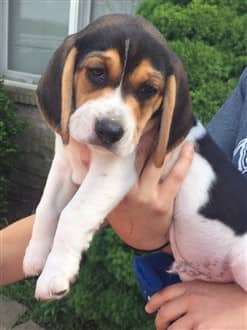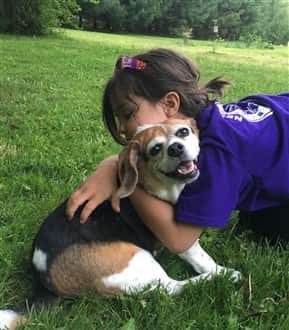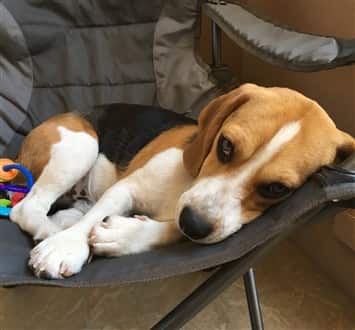Beagle Summer Care
Overview
Summer offers lots of opportunities to enjoy being outside, and that’s great for a high energy breed like the Beagle. However, the strong sun, soaring temperatures, and the summer heat also present quite a few challenges.
Typically, summer-related problems with Beagles can happen very suddenly, so it’s vital to prepare. You’ll want to make some changes in regard to certain care elements including water intake, exercise, protection from hot surfaces, pest control, and more.
This section will cover the top 6 summer care tips to follow for your Beagle puppy or dog, to ensure a safe, happy, and comfortable summer season.
Please note:
BeaglePro is reader-supported, and some of the product suggestions on this page are affiliate links. As an Amazon Associate we earn from qualifying purchases. This is at no extra cost to you and helps us keep this site running.
Summer Care Tip #1 – Keep Your Beagle Well Hydrated
What happens:
Between higher temps both in the house and outside, an increase in activity, and exercise in warmer weather, dogs lose water faster in the summer than other seasons.

1.
Always bringing along water whenever you leave the house with your Beagle. This includes both walks in the neighborhood and any places that you may take your Beagle to visit.
You’ll find that it’s very handy to use a canine water travel container like the H2O4K9 Dog Water Bottle and Travel Bowl ; this is a good size (25 oz.) is made out of stainless steel, and comes in 5 different colors. Stop every 20 to 30 minutes to offer a break and a drink of water.
; this is a good size (25 oz.) is made out of stainless steel, and comes in 5 different colors. Stop every 20 to 30 minutes to offer a break and a drink of water.
2.
If you find yourself always having to remind your Beagle to drink his water when at home, you may need to offer more of an incentive. Do not just top the bowl off; small food particles floating around and stale water are deterrents. So, routinely wash the bowl out and fill it up with fresh, cool water.
Another option is to obtain a canine water foundation; the circulating water often serves to entice dogs to drink. The Pioneer Pet Stainless Steel Fountain Raindrop Design
 is a great choice for this.
is a great choice for this.
3.
As always, it’s recommended to refrain from giving unfiltered tap water to a Beagle. The vast majority of municipality tap water is filled with toxins and contaminants. From carcinogens to fluoride to the 100+ pollutants unregulated by the EPA, tap water has both known and unknown dangers to dogs.
To keep your Beagle safe, have a filtering device connected to your kitchen tap, offer spring water, or use a filter pitcher like the Aquagear Water Filter Pitcher
 (traps 2000% more than Brita).
(traps 2000% more than Brita).
Summer Care Tip #2 – Protect Your Beagle’s Body, Nose, and Paws from the Sun & Heat

Porthos (3 years) and Solo (5 years),
photo courtesy of The Esterbrook Family
What happens:
Dogs are vulnerable to excess sun exposure, and particularly susceptible to paw damage via hot walking surfaces in the summer.
The body:
A Beagle’s fur does a pretty good job protecting the core body from the sun’s rays. However, there’s two elements to keep in mind:
- Canines can indeed get sun burned. Spending a full day outside in sunny, hot weather may result in UV skin damage. And, this will be hard to spot; you’d have to part the fur to notice.
Signs that a Beagle’s is getting too much sun include dry, brittle fur and signs of sunburn include itching (once the burnt skin starts peeling) and areas of the body that are sensitive to touch.
- Another element to keep in mind is your Beagle’s belly. The sun can reflect up from the ground, and without any fur to protect it, a dog’s stomach can become overexposed. While it completely normal for Beagles to have spotted bellies, if you notice that your Beagle is developing new dark spots on the belly, this is often a sign that the sun is affecting the skin there.
The nose:
This is an especially exposed area on dogs. Unlike other areas of a dog’s body that have 5 layers of skin, the nose only has 3. And there’s nothing to protect it. So, it’s not uncommon for a beagle’s nose to be overexposed to summer sun, which can result in a general drying. If not rectified, this can easily spiral into peeling or even cracking.

The paws:
Of all the areas on your Beagle’s body that need attention in the summer, the paws are surely at the top of the list. Hot walking surfaces are to blame for many cases of discomfort and burns to dog’s paws.
The pain threshold for canines is 120 F. At 140 F, burns will occur within 1 minute of contact.
So, does the sidewalk in your neighborhood really get that hot? The answer for many of you is probably yes.
A study of walking surfaces in Florida
showed startling results in regard to dangers for pets. Cement surfaces reached 125 F by 2 PM, red brick hit 125 F at noon and soared to a shocking 134 at 3 PM, and blacktop pavement was a dangerous 125 F at noon, rising to 134 F at 3 and 4 PM, and did not reach a safer 112 F until 7 PM.
What to do:
Protect your Beagle’s body
with canine sunblock if your Beagle will be outside in hot, sunny weather for more than 3 hours.
Protect your Beagle’s nose
with a good nose balm. Apply this once a day. If the nose is very dry or has peeling or cracking issues, apply up to 3 times per day to heal it.
Protect your Beagle’s paws. While an option in the winter, do not try doggie shoes in the summer, these will block the paw’s ability to perspire.
Instead, you’ll find that a quality paw wax in the best choice. Look for one that allows the paws to breath, while offering a layer of protection. Keep in mind that this does not mean that your Beagle will be invincible in the summer; but, it does help quite a bit.
You’ll also want to stay on the grass when possible, and avoid walking during the hottest parts of the day (10 AM to 2 PM).
Below are our recommended summer care items for a canine sunblock, nose balm, and important paw protection wax.
If you do not see the images, try a refresh. And on mobile, you may need to turn your screen horizontal to see all 4.
Summer Care Tip #3 – Help Your Beagle Stay Cool

Jessie and Lily, 'Summer Fun'
photo courtesy of Annie Vega
Whether you are tending to the garden, running out to grab supplies for a family cookout, or otherwise engaging in fun outdoors summer activities, chances are your Beagle wants to be with you and you’d love to have his company as well.
But, your puppy or dog may need some help from you to stay cool and comfortable.
Tips for the car:
1.
Before you let your Beagle into the car, allow the AC to run. Leather or vinyl seats can reach upward of 150 F in the summer, and the air temp in cars on an 80-degree day can range from 112 to 154 F.
2.
While it’s always recommended for safety, keep your Beagle in a car seat or canine car best restraint to help prevent motion sickness, which is often much worse in the summer.
Outside and inside:
1.
If you’ll have your Beagle outside in your yard with you in the summer for a good amount of time, consider setting up a plastic kiddie pool for your puppy or dog. While puppies and adults will enjoy romping around in the water, even seniors
can enjoy laying down in a few inches of water to cool off. This should be set up in the shade if it's very hot out.
2.
Consider a canine cooling mat. These are pressure activated and made of special materials that absorb excess body heat. It’s the perfect answer to help a Beagle in the summer that is easy to use and portable for both indoor and outdoor use.
3.
Raised canine cots are another option. These are great in the summer because they allow for air circulation under a dog’s body.
Below are our recommended summer care items for canine cooling mats and raised cots.
If you do not see the images, try a refresh. And on mobile, you may need to turn your screen horizontal to see all 4.
Summer Care Tip #4 – Know the Signs of Heat Exhaustion and How to React
Even if you are very careful in the summer, there is always a risk that your Beagle may start to suffer from heat exhaustion. So, it’s wise to know the early warning signs and how you should react.
There are two levels of this:
Heat stress
– A dog’s body temperature rises to 103 F. You’ll need to provide intervention to help your Beagle cool down.
Heat stroke
– The next phase (which can happen very quickly after heat stress) – A dog’s body temperature reaches 106 F or higher. This is considered life threatening.
Signs (may occur while a Beagle is active outside, or after coming back indoors):
- Reddened gums
- Heavy panting
- Glazed over eyes
- Heavy or thick drooling
- Rapid heartbeat
- Excessive thirst
- Decreased urination
Without treatment, this can lead to confusion, lethargy, trouble walking, coma, and eventual death.

What to do:
1.
Immediately upon noticing any of these signs, bring your Beagle into an air-conditioned house. If you are away from home and cannot seek shelter inside, bring your dog into the shade.
2.
Work to cool down your Beagle’s body. Do not use ice. Soak hand-towels in cool water, and place these on your Beagle. It can help to run a fan near your dog to displace the air. Note: If you are outside and unable to reach shelter, soak any extra clothing with water (another good reason to always bring along water) and place these on your dog.
Areas to focus on aside from the core body are the paws, groin area, and forelegs.
3.
Offer cool water for your Beagle to drink; but control this so that your dog does not rapidly ingest a large quality at one time, which can lead to killer bloat.
4.
Monitor your Beagle’s temperature. This is a good reason to have a canine thermometer as part of a first aid kit. Most veterinarians recommend working to bring body temp down to 103 before transporting a dog.
5.
Seek vet care. Bring your Beagle to the vet after an episode of heat stress, even if you are able to stabilize your dog, since enduring this type of event puts a tremendous of stress on the body.
In the event of ongoing heat stroke, since this can be fatal, this requires veterinary treatment, which may include IV intervention and oxygen supplementation.
Summer Care Tip #5 – Protect Your Beagle from Summertime Pests
Summer is peak season for mosquitoes, ticks, and fleas.

1. Mosquitoes
are the only way in which heartworms are spread. They pick up heartworm microfilaria (offspring) from an infected animal (dog, or wild animal including fox or coyote) and then transmit the microfilaria to unprotected dogs.
All Beagles should be given heartworm protection.
This said, heartworm protection may repel fleas, but most do not repel mosquitoes. Aside from the heartworm issue, there is the concern of discomfort and possible allergic reaction to mosquito bites in the summer. Just a few bites can cause quite a bit of localized swelling and itching.
2. Fleas
can be a year-round problem, but are much more prolific in the summer. These pests can jump up to 6 feet from one dog to another, and once a Beagle is infested with fleas, the house is often as well.
3. Ticks
are found in every state
in the US, including Alaska and Hawaii.
What to do: Be sure to
protect your Beagle from insects and pests, while using the lowest amount of chemical as possible, since many products can cause adverse reactions.
For a good no-chemical flea, tick, and mosquito repellent, consider Curealia's Pure Natural Insect Repellent for Dogs , which uses organic, all-natural ingredients like olive oil, shea butter, bees xax, lavender, cedarwood, rosewood, and patchouli to repel these summer pests.
, which uses organic, all-natural ingredients like olive oil, shea butter, bees xax, lavender, cedarwood, rosewood, and patchouli to repel these summer pests.
This is a balm; you rub a pea-sized amount between your hands to make it melt, and then apply it to your Beagle’s chest and upper back. Typically, it is applied every 1 to 2 weeks.
Summer Care Tip #6 – Help Your Beagle Cope with Fireworks And/or Lightning Storms
These two events that can be terribly disturbing to dogs both occur mainly in the summer.
Fireworks, which are set off country-wide on the Fourth of July, are very disorienting to canines. The loud reports, sudden flashes of light, and the smell of burning pyrotechnics assault a dog’s senses on a multitude of levels.
In fact, July 5th (the day after Independence Day) is the busiest day of the entire year for animal shelters. This is due to the high number of dogs that are driven to jump fences or break out of confinement in fear, disorientation, utter panic.
Lightning storms, which can often roll in with little warning, can also be very scary to canines. The loud booming claps, flashes of light, and changes in air pressure can be exceedingly disturbing.
What to do:
1.
Over the Fourth of July weekend, be sure to keep your Beagle indoors once the sun sets.
2.
Check the scheduled times for fireworks both in your town and surrounding areas, to know in advance when they will be going off.
3.
During those times, keep doors and windows closed, and drawn your blinds and curtains.
4.
For both fireworks and lightning storms, allow your Beagle to retreat if he desires. While you may want to hold your puppy, or keep your dog close to you, always give him a choice. Many dogs feel more secure in a small ‘den’ area. So, if your Beagle wants to huddle in a closet or hunker down in his bed, let him.
5.
Consider a canine thunder shirt like the ThunderShirt Classic Dog Anxiety Jacket . The idea behind this works very well for many dogs. These are specialized vests (adjustable with Velcro) that offer gentle compression. This type of swaddling method can help keep a dog from panicking. Note that with some dogs, it will be on the 2nd or 3rd time wearing this that you’ll see improvement.
. The idea behind this works very well for many dogs. These are specialized vests (adjustable with Velcro) that offer gentle compression. This type of swaddling method can help keep a dog from panicking. Note that with some dogs, it will be on the 2nd or 3rd time wearing this that you’ll see improvement.
A Final Word
Summer is the ultimate season to really enjoy having your canine family member. But the only way to ensure a safe summer is to think ahead to the obstacles that may occur, preemptively provide the proper care, and know how to react to problems that may develop.
Let's make this the safest, happiest, and most comfortable summer yet for all our Beagle puppies and dogs.

